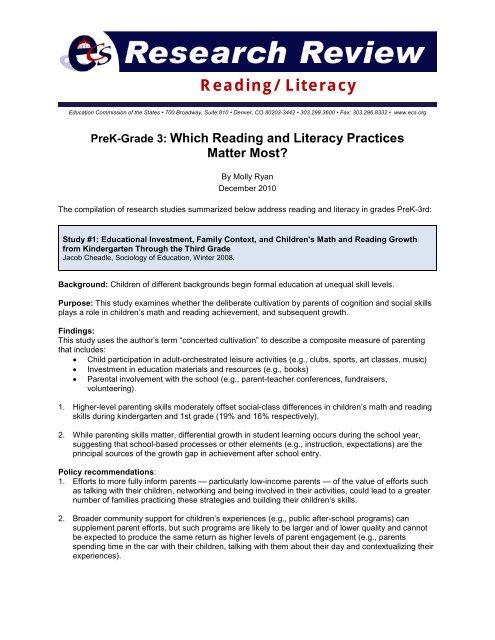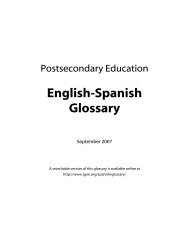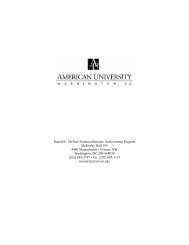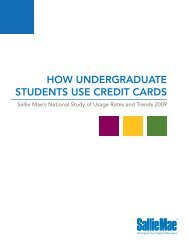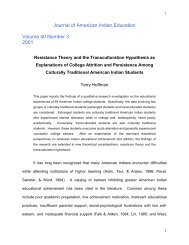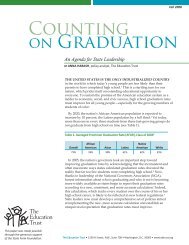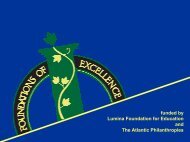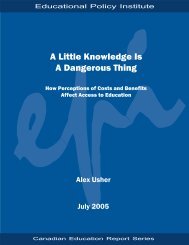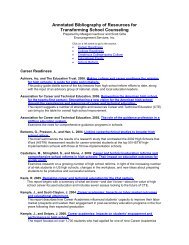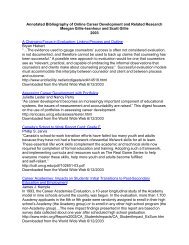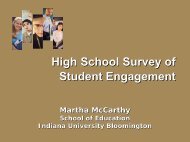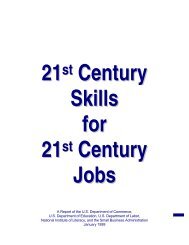Reading/Literacy - Early Grade Reading Mobilization Toolkit
Reading/Literacy - Early Grade Reading Mobilization Toolkit
Reading/Literacy - Early Grade Reading Mobilization Toolkit
You also want an ePaper? Increase the reach of your titles
YUMPU automatically turns print PDFs into web optimized ePapers that Google loves.
<strong>Reading</strong>/<strong>Literacy</strong>Education Commission of the States • 700 Broadway, Suite 810 • Denver, CO 80203-3442 • 303.299.3600 • Fax: 303.296.8332 • www.ecs.orgPreK-<strong>Grade</strong> 3: Which <strong>Reading</strong> and <strong>Literacy</strong> PracticesMatter Most?By Molly RyanDecember 2010The compilation of research studies summarized below address reading and literacy in grades PreK-3rd:Study #1: Educational Investment, Family Context, and Children's Math and <strong>Reading</strong> Growthfrom Kindergarten Through the Third <strong>Grade</strong>Jacob Cheadle, Sociology of Education, Winter 2008.Background: Children of different backgrounds begin formal education at unequal skill levels.Purpose: This study examines whether the deliberate cultivation by parents of cognition and social skillsplays a role in children’s math and reading achievement, and subsequent growth.Findings:This study uses the author’s term “concerted cultivation” to describe a composite measure of parentingthat includes:• Child participation in adult-orchestrated leisure activities (e.g., clubs, sports, art classes, music)• Investment in education materials and resources (e.g., books)• Parental involvement with the school (e.g., parent-teacher conferences, fundraisers,volunteering).1. Higher-level parenting skills moderately offset social-class differences in children’s math and readingskills during kindergarten and 1st grade (19% and 16% respectively).2. While parenting skills matter, differential growth in student learning occurs during the school year,suggesting that school-based processes or other elements (e.g., instruction, expectations) are theprincipal sources of the growth gap in achievement after school entry.Policy recommendations:1. Efforts to more fully inform parents — particularly low-income parents — of the value of efforts suchas talking with their children, networking and being involved in their activities, could lead to a greaternumber of families practicing these strategies and building their children’s skills.2. Broader community support for children’s experiences (e.g., public after-school programs) cansupplement parent efforts, but such programs are likely to be larger and of lower quality and cannotbe expected to produce the same return as higher levels of parent engagement (e.g., parentsspending time in the car with their children, talking with them about their day and contextualizing theirexperiences).
3. While parental influences contribute significantly to the skills with which young children enter school,once children are in school, schools do matter. Policies that provide support for improving the qualityof P-3 instruction could help reduce achievement gaps.For full study: http://www.ingentaconnect.com/content/asoca/soe/2008/00000081/00000001/art00001Study #2: What Works to Improve Student <strong>Literacy</strong> Achievement? An Examination ofInstructional Practices in a Balanced <strong>Literacy</strong> ApproachCatherine Bitter, Miguel Socias, Paul Gubbins and Jennifer O'Day, American Institutes for Research, Journal ofEducation for Students Placed at Risk, 2009.Background: <strong>Literacy</strong> is the foundation for success in school and, in today’s society, for success in life.Purpose: This study describes literacy instruction in San Diego City elementary schools and determineswhich specific practices, if any, were associated with increased student achievement.Findings: Three measures of literacy instruction demonstrated a consistently positive and statisticallysignificant relationship to students’ reading comprehension:1. Instruction focused on higher-level meaning of text: The strongest instructional predictor ofincreased reading comprehension was teachers’ use of higher-level questioning and discussion aboutthe meaning of text. Teachers “telling” students the answers was negatively related to studentoutcomes.2. Writing instruction: Students in classrooms that included greater amounts of writing instruction(discussion about writing and actual composition) improved their reading comprehension more thandid students with less writing.3. Instruction that seeks to foster student responsibility, interactive learning, and sustained, ideafocused,evidence-based discussion has a significant influence on student achievement.4. Some practices — such as engaging in discussion and conversation with peers in the classroom —that were beneficial for non-native English speakers were less so for fluent and native Englishspeakers, and vice versa. This finding has important implications for designing literacy instruction forthe very diverse student populations in most urban districts.Policy recommendations:1. Policies should encourage or support a balanced literacy approach.2. Diverse urban settings should explore and implement a balanced approach to literacy.For full study: http://www.informaworld.com/smpp/content~content=a908605828~db=all~jumptype=rssStudy #3: Socioeconomic Status, English Proficiency, and Late-Emerging <strong>Reading</strong> DifficultiesMichael Kieffer, Teachers College Columbia University, American Educational Research Journal, 2010.Background: Increasingly, concerns are being raised about students who learn to read by 3rd grade butfall behind in later grades. “Late-emerging” reading difficulties may be particularly common among at-riskpopulations.Purpose: This study investigates the prevalence of late-emerging reading difficulties among Englishlanguage learners (ELLs) and native English speakers from diverse socioeconomic backgrounds.Education Commission of the States • 700 Broadway, Suite 810 • Denver, CO 80203-3442 • 303.299.3600 • fax 303.296.8332 • www.ecs.orgPage 2
Findings: Students for whom English is not their first language (ELLs) and those from low-incomebackgrounds disproportionately demonstrate late-emerging reading difficulties. Of the two risk factors, thelevel of family income has the strongest influence.1. ELLs are more likely than native English speakers of the same income level to demonstrate readingdifficulties by <strong>Grade</strong> 3. However, native English speakers also are at risk for reading difficulties in theupper elementary grades or middle school.2. Poor students are at substantially higher risk for developing reading difficulties during eachdevelopmental period, but particularly for difficulties that emerge before grade 3.3. Among students from upper income backgrounds, the risk for difficulties emerging in middle school isslightly higher than the risk for early-emerging difficulties. This suggests that the particular challengesof adolescent literacy apply to all students.Policy recommendations:1. Because family income is a more prominent predictor of late-emerging reading difficulties, it isimportant to continue to closely monitor all low income students’ reading abilities through high school.2. Because more affluent students are at greater risk for late-emergent reading difficulties than they arefor early reading difficulties, all students should have their reading skills monitored throughoutelementary and middle grades.3. Upper elementary-level through high school-level reading instruction should emphasize vocabularydevelopment and critical thinking skills.For full study: http://edr.sagepub.com/content/39/6/484Study #4: The Relation Between the Type and Amount of Instruction and Growth in Children’s<strong>Reading</strong> CompetenciesSusan Sonnenschein, Amy Benson and Laura Stapleton, University of Maryland Baltimore County, AmericanEducational Research Journal, November 11, 2009.Background: Children with limited literacy experiences may be more sensitive to or in need of specificinstruction, such as letters/sounds, than children entering school with a greater foundation of prior literacyexperiences.Purpose: To consider the longer term effectiveness of two instructional approaches –– phonics andintegrated language arts –– and to investigate the relation between classroom instructional practices andchildren’s reading skills from kindergarten through 5th grade.Findings: Children’s entry-level skills, ethnicity and parents’ education level predicted children’s readingscores at the end of kindergarten. To a lesser extent, type and amount of reading instruction predictedchildren’s reading scores. However, the type of instruction appeared to matter only in kindergarten and1st grade.1. <strong>Reading</strong> instruction and characteristics of teachers• The number of years teachers taught was not related to the amount of time that their classesreportedly engaged in reading activities. The only exception was in 3rd grade, where teacherswith three or fewer years of experience reported less reading time than their more experiencedpeers.• The number of reading courses taken by teachers was related to the frequency with whichkindergarten and 1st-grade teachers reported implementing phonics activities and integratedlanguage arts activities (vocabulary, discussion, explaining what they have read, etc.).• Neither the number of years of teaching nor the number of reading courses taken was uniquelyrelated to reading scores of children at any time point.Education Commission of the States • 700 Broadway, Suite 810 • Denver, CO 80203-3442 • 303.299.3600 • fax 303.296.8332 • www.ecs.orgPage 3
2. Growth in children's reading skills• Only in kindergarten did the type of instruction matter, with phonics instruction predicting higherspring reading scores.• Children’s reading-related skills at the start of kindergarten predicted their reading scores at theend of kindergarten and beyond.3. Schooling factors and children’s reading development• Children who entered kindergarten and 1st grade with more advanced phonics skills benefitedfrom an instructional emphasis on the meaning of the text.• Children most at risk for reading difficulties did not benefit as much from integrated language artsas those with higher skills.• At kindergarten level – Time spent on reading was positively related to the spring reading score;and children in kindergarten benefited from a direct instructional focus on phonics acquisition.• At 1st- and 3rd-grade levels – Time spent reading was more beneficial for those children whoseentry scores were slightly above the mean.• At 5th-grade level – Children with lower reading scores showed more benefit from more timespent reading.Policy recommendations:1. <strong>Early</strong> reading instruction should include a direct instructional focus on phonics acquisition duringkindergarten, especially for children starting school with fairly limited literacy experience.2. Instruction focused on decoding skills should be provided to weaker readers; greater focus oncomprehension should be provided to those children with stronger decoding and vocabulary skills.3. Although young children may need instruction in both decoding skills and comprehension, the exactbalance between the two should vary depending upon the child’s skills.For full study: http://www.eric.ed.gov/ERICWebPortal/search/detailmini.jsp?_nfpb=true&_&ERICExtSearch_SearchValue_0=EJ887171&ERICExtSearch_SearchType_0=no&accno=EJ887171Molly Ryan, ECS Researcher, may be reached at 303.299.3614 or mryan@ecs.org© 2010 by the Education Commission of the States (ECS). All rights reserved. ECS is the only nationwide, nonpartisan interstatecompact devoted to education.ECS encourages its readers to share our information with others. To request permission to reprint or excerpt some of our material,please contact the ECS Information Clearinghouse at 303.299.3675 or e-mail ecs@ecs.org.Equipping Education Leaders, Advancing IdeasEducation Commission of the States • 700 Broadway, Suite 810 • Denver, CO 80203-3442 • 303.299.3600 • fax 303.296.8332 • www.ecs.orgPage 4


